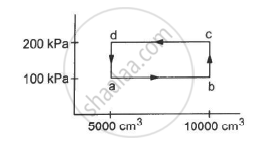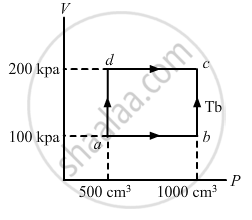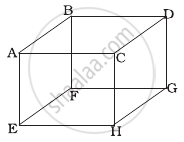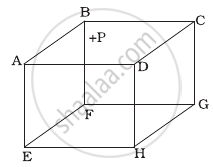Advertisements
Advertisements
प्रश्न
Half mole of an ideal gas (γ = 5/3) is taken through the cycle abcda, as shown in the figure. Take `"R" = 25/3"J""K"^-1 "mol"^-1 `. (a) Find the temperature of the gas in the states a, b, c and d. (b) Find the amount of heat supplied in the processes ab and bc. (c) Find the amount of heat liberated in the processes cd and da.

उत्तर
Given:
Number of moles of the gas,
n = 0.5 mol

`"R" = 25/3 `J/mol -K
`gamma =5/3`
(a) Temperature at a = Ta
PaVa =nRTa
`=> "T""a" = ("P"_"a""V"_"a")/("n""R") = (100 xx 10^3 xx 5000 xx 10^-6)/(0.5 xx 25/3) = 120 "K"`
Similarly, temperature at b,
`"T"_"b" = ("P"_b"V"_"b")/("n""R")`
`"T"_"b" =( 100 xx 10^3 xx 10000 xx 10^-6)/(0.5 xx 25/3)`
Tb =240 K
Similarly, temperature at c is 480 K and at d is 240 K.
(b) For process ab,
dQ = ncpdT
[Since ab is isobaric]
`"d""Q" = 1/2 xx ("R"gamma)/(gamma-1) ("T"_"b" - "T"_"a")`
`"d""Q" =1/2 xx ((25 xx 5)/(3 xx 3))/(5/3 -1 ) xx (240 -120 )`
`"d""Q" = 1/2 xx 125 /9 xx 3/2 xx (120)`
dQ = 1250 J
For line bc, volume is constant. So, it is an isochoric process.
dQ = dU + dW
[dW = 0, isochoric process]
dQ = dU = nCvdT
dQ = nCv (Tc - Tb)
`"d""Q" = 1/2 xx ((25/3))/[[(5/3)-1]] xx (240)`
`"d""Q" = 1/2 xx 25/3 xx 3/2 xx 240 =1500 "J"`
(c) Heat liberated in cd (isobaric process),
dQ = − nCpdT
`"d""Q" = -1/2 xx( gamma "R")/(gamma-1) xx ("T"_d -"T"_"c")`
`"d""Q" = -1/2 xx 125/9 xx 3/2 xx ( 240 -480)`
`"d""Q" = -1/2 xx 125/6 xx 240 = 2500 "J"`
Heat liberated in da (isochoric process),
⇒ dQ = dU
Q= −nCvdT
`"d""Q" = -1/2 xx "R" /(gamma -1 )("T"_"a"-"T"_"d")`
`"d""Q" = -1/2 xx 25/2 xx (120-240)`
`"d""Q" = 25/4 xx 120 =750 "J"`
APPEARS IN
संबंधित प्रश्न
Keeping the number of moles, volume and temperature the same, which of the following are the same for all ideal gases?
Consider the quantity \[\frac{MkT}{pV}\] of an ideal gas where M is the mass of the gas. It depends on the
Find the number of molecules in 1 cm3 of an ideal gas at 0°C and at a pressure of 10−5mm of mercury.
Use R = 8.31 J K-1 mol-1
A sample of 0.177 g of an ideal gas occupies 1000 cm3 at STP. Calculate the rms speed of the gas molecules.
Let Q and W denote the amount of heat given to an ideal gas and the work done by it in an isothermal process.
A rigid container of negligible heat capacity contains one mole of an ideal gas. The temperature of the gas increases by 1° C if 3.0 cal of heat is added to it. The gas may be
(a) helium
(b) argon
(c) oxygen
(d) carbon dioxide
The figure shows a cylindrical container containing oxygen (γ = 1.4) and closed by a 50-kg frictionless piston. The area of cross-section is 100 cm2, atmospheric pressure is 100 kPa and g is 10 m s−2. The cylinder is slowly heated for some time. Find the amount of heat supplied to the gas if the piston moves out through a distance of 20 cm.

The ratio of the molar heat capacities of an ideal gas is Cp/Cv = 7/6. Calculate the change in internal energy of 1.0 mole of the gas when its temperature is raised by 50 K (a) keeping the pressure constant (b) keeping the volume constant and (c) adiaba
An ideal gas is taken through a process in which the pressure and the volume are changed according to the equation p = kV. Show that the molar heat capacity of the gas for the process is given by `"C" ="C"_"v" +"R"/2.`
Two ideal gases have the same value of Cp / Cv = γ. What will be the value of this ratio for a mixture of the two gases in the ratio 1 : 2?
The volume of an ideal gas (γ = 1.5) is changed adiabatically from 4.00 litres to 3.00 litres. Find the ratio of (a) the final pressure to the initial pressure and (b) the final temperature to the initial temperature.
An ideal gas of density 1.7 × 10−3 g cm−3 at a pressure of 1.5 × 105 Pa is filled in a Kundt's tube. When the gas is resonated at a frequency of 3.0 kHz, nodes are formed at a separation of 6.0 cm. Calculate the molar heat capacities Cp and Cv of the gas.
1 mole of an ideal gas is contained in a cubical volume V, ABCDEFGH at 300 K (Figure). One face of the cube (EFGH) is made up of a material which totally absorbs any gas molecule incident on it. At any given time ______.

ABCDEFGH is a hollow cube made of an insulator (Figure). Face ABCD has positive charge on it. Inside the cube, we have ionized hydrogen. The usual kinetic theory expression for pressure ______.

- will be valid.
- will not be valid since the ions would experience forces other than due to collisions with the walls.
- will not be valid since collisions with walls would not be elastic.
- will not be valid because isotropy is lost.
Diatomic molecules like hydrogen have energies due to both translational as well as rotational motion. From the equation in kinetic theory `pV = 2/3` E, E is ______.
- the total energy per unit volume.
- only the translational part of energy because rotational energy is very small compared to the translational energy.
- only the translational part of the energy because during collisions with the wall pressure relates to change in linear momentum.
- the translational part of the energy because rotational energies of molecules can be of either sign and its average over all the molecules is zero.
When an ideal gas is compressed adiabatically, its temperature rises: the molecules on the average have more kinetic energy than before. The kinetic energy increases ______.
- because of collisions with moving parts of the wall only.
- because of collisions with the entire wall.
- because the molecules gets accelerated in their motion inside the volume.
- because of redistribution of energy amongst the molecules.
